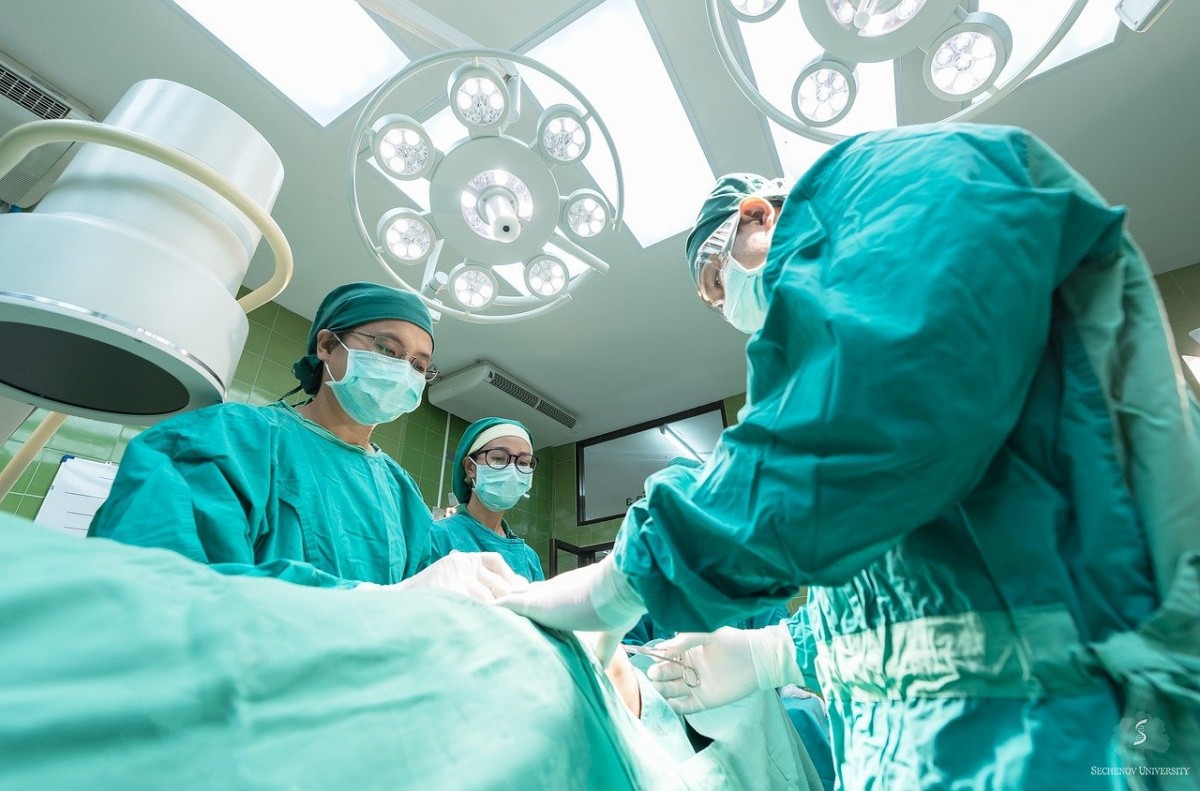- Абитуриенту
-
Обучающемуся
- Я – профессионал
- Локальные нормативные акты
- Образовательные программы
- Стоимость обучения
- Университет - обучающемуся
- Центр карьеры
- Учебный центр по маркировке
- Учеба и наука
- Школы мастерства
- Комфортная среда обучения
- Образовательные стандарты
- Стипендии и материальная поддержка
- Вакантные места
- Общежития
- Сотруднику
- Аккредитация специалистов
-
About University
- Mission & Brand Strategy
- University Leadership
- Rector's Welcome
- History
- Regulatory Documents
- Contacts
- Staff
- International Recruitment
- Partners
Applicants- Why Sechenov University
- Degree Programmes in English
- Preparatory Courses
- Non-Degree Programmes
- Transfer from other Institutions
02.11.2020Leg skin replaced with abdominal tissue grown in patient

Sechenov doctors performed a rare surgery on a patient who had a large skin lesion on the leg. They grew a new skin flap on the patient’s abdomen and successfully transplanted it onto the affected area. Several months after the surgery, the patient fully recovered and reported a higher quality of life.
Plastic surgery is sometimes essential to manage certain conditions affecting the quality of life. For example, a number of skin lesions can be congenital (present from birth). Reconstructive operations may also be required during patient rehabilitation after traumas, deformity treatment, and oncoplastic surgery. Medics from Sechenov University performed a reconstructive procedure on a patient who suffered from a naevus on the lower limb. This case, quite unusual because of the massiveness of the lesion, has been reported in the journal Plastic and Reconstructive Surgery – Global Open.
The 27-year-old female was presented with a large congenital circular pigmented naevus which covered more than 80% of the calf on the left lower limb. The lesion, measuring 50 × 25 cm2, was causing serious discomfort and could pose an oncology hazard. The medics decided to excise the naevus and replace the defective area with a prefabricated bipedicle deep inferior epigastric artery (DIEP) flap.
The procedure required transplantation of donor tissue onto the lesion site. The donor tissue is normally taken from another area of the patient’s skin. In this particular case, however, the patient had a low body mass index and not much available tissue, so the doctors had to virtually ‘grow’ extra tissue for transplantation. To achieve this, they implanted 2 expanders into the anterior abdominal wall 6 months prior to the principal surgery.
During the main operation, the expanders were removed, and the resulting bilateral DIEP flap (45 × 20 cm2) was taken together with the superficial veins. In parallel, the lesion area was prepared: the naevus was excised, and the recipient vessels were prepared for microvascular anastomosis (blood vessel connection). After transferring the flap onto the recipient site, 5 microsurgical anastomoses were performed.
The patient stayed in hospital for 14 days and received manual compression of the transferred flap. Temporary venous congestion was observed — quite expectedly in this procedure. A week after the operation, the patient started physical exercise.
Half a year later, the left lower limb was mobile, and the transplanted flap was viable. The donor site was also in a good condition. Most importantly, the patient felt much more aesthetic and reported higher satisfaction with the quality of life.
According to the authors of the paper, the most difficult issue in the plastic surgery reconstruction of the lower limbs is venous drainage. The use of a DIEP flap, as in the presented clinical case, is the least traumatic procedure for the anterior abdominal wall. However, the legs and the abdomen have quite different vascular anatomies, so it is crucial to transplant the flap with the highest possible attention to the venous anastomosis.
This clinical case is presented by the Department of Oncology, Radiotherapy, and Plastic Surgery (Institute for Clinical Medicine, Sechenov University), the Laboratory of Bioengineering and Prototyping of Organs and Tissues (Institute for Regenerative Medicine, Sechenov University), and the Department of Maxillofacial Surgery (Caen University Hospital, Caen, France).
Photo credit: Pixabay 1807541Embed on website
Leg skin replaced with abdominal tissue grown in patient

Sechenov doctors performed a rare surgery on a patient who had a large skin lesion on the leg. They grew a new skin flap on the patient’s abdomen and successfully transplanted it onto the affected area. Several months after the surgery, the patient fully recovered and reported a higher quality of life.
Plastic surgery is sometimes essential to manage certain conditions affecting the quality of life. For example, a number of skin lesions can be congenital (present from birth). Reconstructive operations may also be required during patient rehabilitation after traumas, deformity treatment, and oncoplastic surgery. Medics from Sechenov University performed a reconstructive procedure on a patient who suffered from a naevus on the lower limb. This case, quite unusual because of the massiveness of the lesion, has been reported in the journal Plastic and Reconstructive Surgery – Global Open.
The 27-year-old female was presented with a large congenital circular pigmented naevus which covered more than 80% of the calf on the left lower limb. The lesion, measuring 50 × 25 cm2, was causing serious discomfort and could pose an oncology hazard. The medics decided to excise the naevus and replace the defective area with a prefabricated bipedicle deep inferior epigastric artery (DIEP) flap.
The procedure required transplantation of donor tissue onto the lesion site. The donor tissue is normally taken from another area of the patient’s skin. In this particular case, however, the patient had a low body mass index and not much available tissue, so the doctors had to virtually ‘grow’ extra tissue for transplantation. To achieve this, they implanted 2 expanders into the anterior abdominal wall 6 months prior to the principal surgery.
During the main operation, the expanders were removed, and the resulting bilateral DIEP flap (45 × 20 cm2) was taken together with the superficial veins. In parallel, the lesion area was prepared: the naevus was excised, and the recipient vessels were prepared for microvascular anastomosis (blood vessel connection). After transferring the flap onto the recipient site, 5 microsurgical anastomoses were performed.
The patient stayed in hospital for 14 days and received manual compression of the transferred flap. Temporary venous congestion was observed — quite expectedly in this procedure. A week after the operation, the patient started physical exercise.
Half a year later, the left lower limb was mobile, and the transplanted flap was viable. The donor site was also in a good condition. Most importantly, the patient felt much more aesthetic and reported higher satisfaction with the quality of life.
According to the authors of the paper, the most difficult issue in the plastic surgery reconstruction of the lower limbs is venous drainage. The use of a DIEP flap, as in the presented clinical case, is the least traumatic procedure for the anterior abdominal wall. However, the legs and the abdomen have quite different vascular anatomies, so it is crucial to transplant the flap with the highest possible attention to the venous anastomosis.
This clinical case is presented by the Department of Oncology, Radiotherapy, and Plastic Surgery (Institute for Clinical Medicine, Sechenov University), the Laboratory of Bioengineering and Prototyping of Organs and Tissues (Institute for Regenerative Medicine, Sechenov University), and the Department of Maxillofacial Surgery (Caen University Hospital, Caen, France).
Photo credit: Pixabay 1807541



